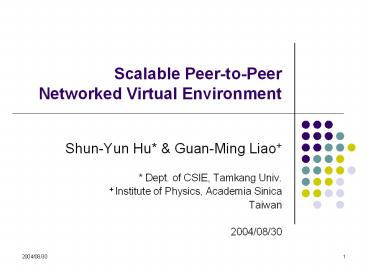Scalable Peer-to-Peer Networked Virtual Environment - PowerPoint PPT Presentation
Title:
Scalable Peer-to-Peer Networked Virtual Environment
Description:
Procedure (MOVE) Send movement to all neighbors, mark boundary neighbors. B. Neighbors check for AOI & enclosing neighbors overlap ... – PowerPoint PPT presentation
Number of Views:20
Avg rating:3.0/5.0
Title: Scalable Peer-to-Peer Networked Virtual Environment
1
Scalable Peer-to-Peer Networked Virtual
Environment
- Shun-Yun Hu Guan-Ming Liao
- Dept. of CSIE, Tamkang Univ.
- Institute of Physics, Academia Sinica
- Taiwan
- 2004/08/30
2
The BIG Question
- How do we create a true cyberspace (Networked
Virtual Environment)? - True means
- 3D-based, interactive and persistent
- Feels realistic and immersive
- REALLY BIG ?
- Scalability Problem
3
Issues for Creating NVE
- Consistency
- Performance (Responsiveness) multiplayer
- Security
- Scalability
- Persistency massively multiplayer
- Reliability (Fault-tolerance)
4
The Scalability Problem
- Many nodes on a 2D plane ( gt 1,000,000)
- Need to interact with those within Area of
Interest (AOI) - How does each node receive only the necessary
messages?
5
Scalability Solutions
- Strategies
- Increase resource ? More servers
- Decrease consumption ? Interest management
(message filtering) - Architectures
- Point-to-point (LAN) tens 101
- Client-server hundreds 102
- Server-cluster thousands 103
- ? millions 106
- Peer-to-Peer
6
Promise Challenge of P2P
- Promises
- Growing resource, decentralized ? Scalable
- Commodity hardware ? Affordable
- Nobody has done it yet! ? Cool ?
- Challenges
- Topology maintenance ? dynamic join/leave
- Efficient content retrieval ? no global knowledge
7
Design Goals
- Observation desired content is specifically
defined (messages from neighbors within AOI) - ? locality of interest to be exploited
- Solve the Neighbor Discovery Problem in a
fully-distributed, message-efficient manner. - Specific goals
- Scalability ? Limit minimize message traffics
- Performance ? Direct connection with AOI
neighbors
8
Voronoi Diagram
- Plane partitioned into regions by sites, each
region contains all the points closest to its
site - Can be used to find k-nearest neighbor easily
Neighbors
Region
Site
9
Design Concepts
- Use Voronoi to solve Neighbor Discovery Problem
- Identify enclosing and boundary neighbors
- Each node constructs a Voronoi of its neighbors
- Enclosing neighbors are maintain as the minimal
set - Mutual collaboration in neighbor discovery
Circle Area of Interest (AOI)
White self
Yellow enclosing neighbor
L. Blue boundary neighbor
Pink enclosing boundary
Green other neighbor
D. Blue unknown neighbor
10
Procedure (JOIN)
- Send join request to any existing node
- Join request forwarded to acceptor region
- Acceptor regions node sends back its neighbor
list - Joining host contacts those neighbors one-by-one
11
Procedure (MOVE)
- Send movement to all neighbors, mark boundary
neighbors - B. Neighbors check for AOI enclosing neighbors
overlap - Connect to new neighbor upon notification (update
Voronoi) - Disconnect any non-overlapped neighbor
12
Procedure (LEAVE, etc.)
- Leave
- Simply disconnect
- Others update Voronoi (query new boundary)
- Other actions (chat, jump, trade)
- Exchange message with individual or all neighbors
13
Problems of Voronoi Approach
- Performance
- Circular round-up of nodes
- Redundant message sending
- Incomplete neighbor discovery
- Inconsistent / incorrect neighbor list
- Fast moving node
14
Related Works
- P2P support for MMP Games (Univ. of Pennsylvania)
- DHT-based, Pastry Scribe
- Knutsson et al. INFOCOM 2004
- P2P Message Exchange Scheme for LS-NVE (Univ. of
Tokyo) - Constant exchange of neighbor list
- Kawahara et al. Telecommunication System 2004
- Solipsis (France Telecomm RD)
- Mutual collaboration between nodes, maintain
within convex hull - Keller and Simon. PDPTA 2003
15
Summary
- Scalability in P2P is a neighbor discovery
problem - Desirable properties for Voronoi P2P NVE
- Efficient message transmission due to direct
connection - Low overhead P2P topology maintenance
- Problems with current approach
- Moving speed limit
- Lack of recovery mechanism from inconsistency
- Interesting and promising direction
16
Future Works
- Recovery mechanism from inconsistency
- Variable-radius AOI
- Game states persistency (OceanStore)
- 3D content distribution (3D streaming on P2P)
- Towards a true cyberspace ?
17
Acknowledgement
- WISE Lab, Tamkang Univ.
- Joaquin Keller (France Telecomm RD)
- Laboratory of Statistical Computational
Physics, Academia Sinica - Anonymous reviewers
- Dr. Chin-Kun Hu
- Prof. Wen-Bing Horng
- Prof. Jiung-Yao Huang
18
Q A
- Thank You!































